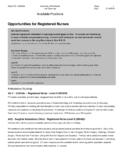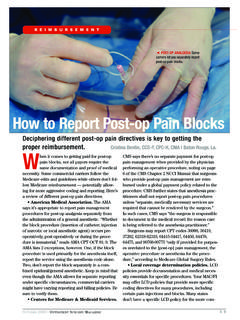Transcription of For Joint Commission Resources
1 For Joint Commission ResourcesEditor:Steven BermanCopyeditor:Helen FryProject Manager:Andrew Bernotas Production Manager:Johanna HarrisAssociate Director:Cecily PewExecutive Director:Catherine Chopp HinckleyJoint Commission /JCR Reviewers:Pat Adamski, Peter Angood, Victor Butler, Rick Croteau, NanneFinis, Jerod Loeb, Paul Schyve, Laura SmithJoint Commission Resources MissionThe mission of Joint Commission Resources is to continuously improve the safety and quality ofcare in the United States and in the international community through the provision of education andconsultation services and international Commission Resources educational programs and publications support, but are separate from,the accreditation activities of the Joint Commission . Attendees at Joint Commission Resourceseducational programs and purchasers of Joint Commission Resources publications receive nospecial consideration or treatment in, or confidential information about, the accreditation inclusion of an organization name, product, or service in a Joint Commission publication shouldnot be construed as an endorsement of such organization, product, or service, nor is failure toinclude an organization name, product, or service to be construed as disapproval.
2 2005 by the Joint Commission on Accreditation of Healthcare OrganizationsJoint Commission Resources , Inc. (JCR), a not-for-profit affiliate of the Joint Commission onAccreditation of Healthcare Organizations ( Joint Commission ), has been designated by the JointCommission to publish publications and multimedia products. JCR reproduces and distributes thesematerials under license from the Joint rights reserved. No part of this publication may be reproduced in any form or by any meanswithout written permission from the in the 5 4 3 2 1 Requests for permission to make copies of any part of this work should be mailed toPermissions EditorDepartment of PublicationsJoint Commission ResourcesOne Renaissance BoulevardOakbrook Terrace, Illinois 0-86688-950-7 Library of Congress Control Number: 2005931766 For more information about Joint Commission Resources , please visit 91 Efficient management of patient flow has become one of the most importantissues on the agenda of many relatively new concept hasbecome increasingly recognized in the hospital community as imbalancebetween hospital patient demand and capacity occurs more often.
3 As hospitalcapacity becomes more frequently insufficient to meet growing patient demand,periodic fluctuations in patient volume overwhelm the hospital s capacity torespond. Furthermore, emergency department (ED) overcrowding, nurse staffingshortages, and medical errors have all been linked to shortages of hospital bedsand associated stresses on staff when patient volume complex problem of patient flow management extends beyond the hospitalto include pre-hospital patient flow (for example, why patients use the ED ratherthan their primary care physicians) and post-hospital patient flow (for example,availability of rehabilitation or skilled nursing facility beds). Comprehensivecoverage of all these issues would not be possible in this chapter, but the referencesshown in Table (page 92) provide further information for those who areinterested in these of bottlenecks in patient flow within the hospital poses a very complexissue.
4 Many hospital overcrowding problems in particular departments are theconsequence of the downstream bottleneck in patient flow for example, abackup in the ED occurs because of a lack of beds in the intensive care unit(ICU). It is analogous to having a wide pipe followed by a narrow pipe thatCHAPTER 4 Optimizing Patient Flow by Managing Its VariabilityEugene Litvak, the throughput of their serial connection. However, this is not alwaysobvious in a hospital environment. Although this complex technical problem isalso beyond the scope of this chapter, we will concentrate on another veryimportant issue variability in patient flow and its impact on hospital revenue,nurse staffing, and quality of Goal of Patient Flow Improvement: Myths and Reality There are many myths about the desired outcomes of improved patient flowthrough acute care settings, including the following: High unit or hospital occupancy rates High utilization rates in different units Reduction in the time of patient transfers between units to, in itself, improveshospital flow Achieving any of these three goals could make particular hospital departmentshappy for a while, but none can guarantee achievement of what should be theoverall goal.
5 Maximizing patient throughput , defined as the number of patientsmoved through the hospital during a month, year, or other time period, andincreasing access to care. Moreover, these goals do not necessarily lead to the rightFrom Front Office to Front Line: Essential Issues for Health Care Leaders Joint Commission Resources : Managing Patient Flow. Strategies and Solutionsfor Addressing Hospital Overcrowding. (accessed Jun. 19, 2005). Institute of Medicine: The Future of Emergency Care in the United States HealthSystem. (accessed Jun. 19, 2005). Institute for Healthcare Improvement: Patient Flow: Getting (accessed Jun. 19, 2005). Boston University: Management of Variability (accessed Jun. 19, 2005).Further Resources for Patient Flow TABLE to maximize throughput , as they could put the system under unnecessarystress. It is important to dispel these myths (seeSidebar , page 94), so thatorganizations can focus their improvement efforts course, increased throughput should never come at the expense of quality ofcare (for example, by artificially reducing patient length of stay).
6 Neither shouldmanaging scheduled demand or improving the discharge process necessarily bethe goal. But they are definitely among the right (although not sufficient) meansto achieve an overall goal to increase patient throughput while maintaining orincreasing quality of care, thereby maximizing patient access to care and improvingthe financial health of health care should increasing patient throughput be the goal? ED overcrowding,excessive demand, and limited access to care cannot be resolved by are systemic problems. As soon as an individual hospital reduces its ED waiting time, it is likely to become a magnet to patients who otherwisewould go to its neighboring hospitals. Only increased hospital patient throughputwould be an objective sign of improved access to care and better management of Operations ManagementThe Harvard Business School McDonald s and Burger King case studies are wellknown at many business them one can learn that operations atthese two food chains have a huge impact on work climate, marketability, financialresults, and so are two main differences between McDonald s andBurger King described in the case first is that McDonald s has a grill,whereas Burger King has a second is that Burger King must maintainadditional inventory compared to McDonald two differences alone have a major impact not just on cost but also on jobretention, management style, salaries, and many other parameters.
7 For example,assembly workers at Burger King must listen carefully to all communications as an expanded inventory increases the likelihood of misassembling sandwiches,which along with customizing sandwiches, potentially reduces productivity andrevenue. On the other hand, it is possible at Burger King to bypass a slow worker,whereas McDonald s connected system (all workers must work at the same pace)places greater importance on Patient Flow by Managing Its Variability CHAPTER 494 From Front Office to Front Line: Essential Issues for Health Care LeadersMyth 1. High Unit or Hospital Occupancy Rates Is a Goal of Improved Hospital FlowA high occupancy rate does not provide any detail on the effectiveness of patientflow. Consider this analogy: A restaurant manager who counts the number of tablesoccupied at lunchtime has learned little about the ability to serve its customers.
8 Ifthe restaurant is full of diners, it does not therefore follow that the throughput andthe revenue are optimal. To get a clear picture of flow, the restaurant manager mustconsider how often those tables turn 2. High Utilization Rates in Different Units Is a Goal of Improved Hospital Flow In general, high utilization rates will either increase waiting time for incomingpatients or increase the likelihood of rejecting or diverting patients, particularly withrandom patient demand for the unit (or hospital). Assuming a smooth scheduleddemand, a hospital with a greater proportion of scheduled patients in the incomingflow can afford a higher utilization rate without diverting more patients. With agreater proportion of unscheduled patients (for example, from the ED), the hospitalshould keep a lower utilization rate so as not to divert more patients becausemore rooms need to be left open for unpredictable arrivals.
9 Thus, increasing theutilization rate and reducing the number of open rooms has the potential to divertfrom the very goal of maximizing patient throughput and access to care. Rejectionrates or waiting times for any incoming patient flow mix of scheduled andunscheduled patients can be calculated to support this assertion. Myth 3. Reduce the Time of Patient Transfers Between Units to Improve Hospital Flow Suppose that the average time to transfer a patient from the ED to an inpatient bedhas been reduced to 15 minutes, yet patient throughput stays the same. Such ascenario would be caused by a downstream bottleneck to patient flow (for example,no nursing home beds to which to discharge patients). There is no benefit ofputting ED and floor staff under stress to achieve this artificial goal of 15-minutetransfer time when patients will only wait much longer on the floor, and the overalllength of stay and throughput will stay the same.
10 On the other hand, maximizingthroughput will, by definition, guarantee that the average time of patient transfersbetween any units remains low. Source:Institute for Healthcare Improvement: IHI Web member discussion. Patient Flow. (access restricted to IHI registrants).Three Myths of the Goals for Improved Patient Flow SIDEBAR , operating systems of the health care delivery system have a significantimpact on such things as the work climate, staffing, and financial we are trying to change health care delivery without changing its core are trying to achieve the results we want just by changing the reimbursementsystem, by asking different parties to collaborate, and so forth. Imagine, forexample, that the Ford Motor Company found that their cars could not competeon the probably would work to improve the engine, transmission,or product they could do with their cars to compete with othermanufacturers.



